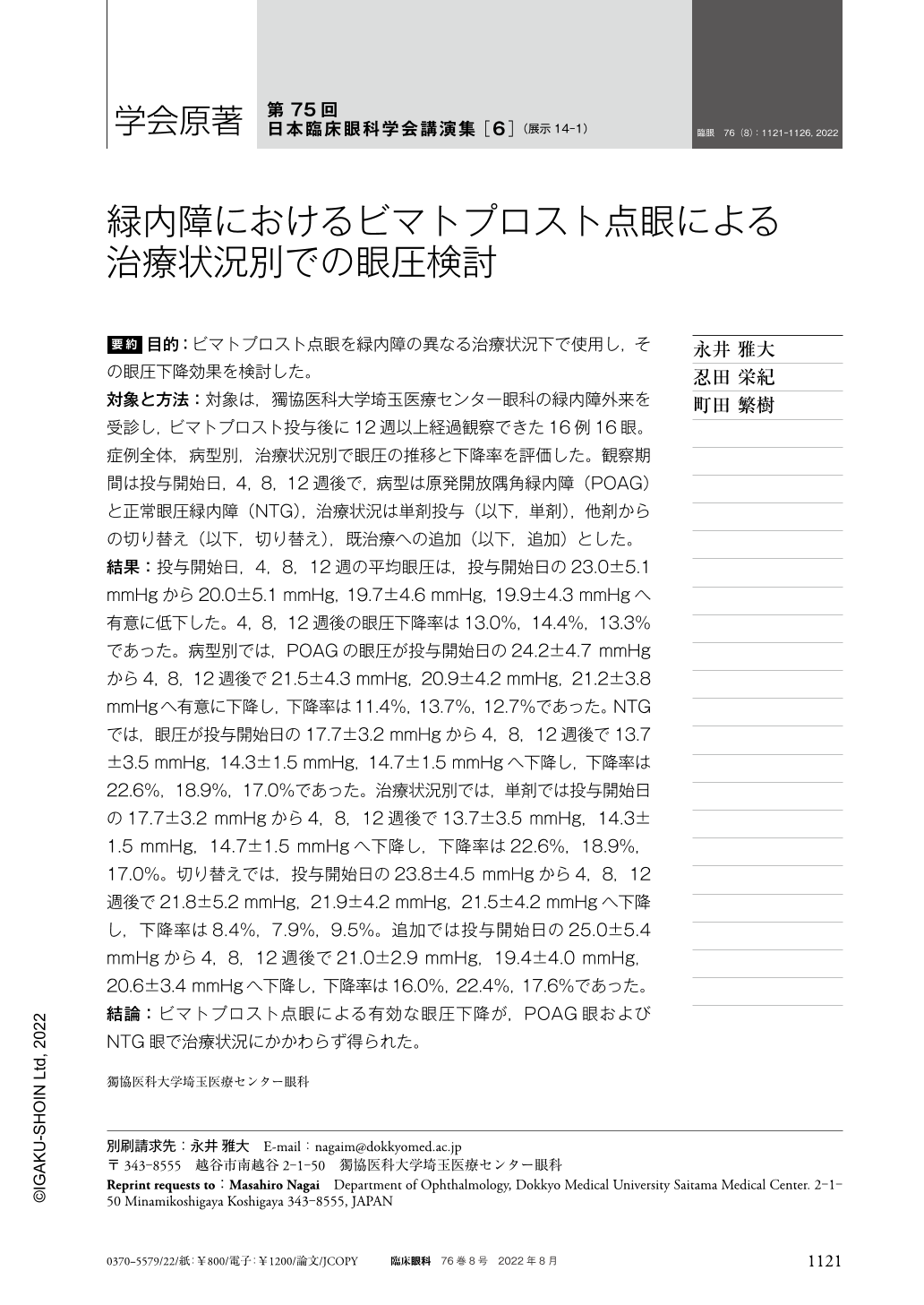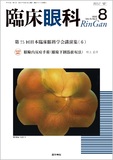Japanese
English
- 有料閲覧
- Abstract 文献概要
- 1ページ目 Look Inside
- 参考文献 Reference
要約 目的:ビマトプロスト点眼を緑内障の異なる治療状況下で使用し,その眼圧下降効果を検討した。
対象と方法:対象は,獨協医科大学埼玉医療センター眼科の緑内障外来を受診し,ビマトプロスト投与後に12週以上経過観察できた16例16眼。症例全体,病型別,治療状況別で眼圧の推移と下降率を評価した。観察期間は投与開始日,4,8,12週後で,病型は原発開放隅角緑内障(POAG)と正常眼圧緑内障(NTG),治療状況は単剤投与(以下,単剤),他剤からの切り替え(以下,切り替え),既治療への追加(以下,追加)とした。
結果:投与開始日,4,8,12週の平均眼圧は,投与開始日の23.0±5.1mmHgから20.0±5.1mmHg,19.7±4.6mmHg,19.9±4.3mmHgへ有意に低下した。4,8,12週後の眼圧下降率は13.0%,14.4%,13.3%であった。病型別では,POAGの眼圧が投与開始日の24.2±4.7mmHgから4,8,12週後で21.5±4.3mmHg,20.9±4.2mmHg,21.2±3.8mmHgへ有意に下降し,下降率は11.4%,13.7%,12.7%であった。NTGでは,眼圧が投与開始日の17.7±3.2mmHgから4,8,12週後で13.7±3.5mmHg,14.3±1.5mmHg,14.7±1.5mmHgへ下降し,下降率は22.6%,18.9%,17.0%であった。治療状況別では,単剤では投与開始日の17.7±3.2mmHgから4,8,12週後で13.7±3.5mmHg,14.3±1.5mmHg,14.7±1.5mmHgへ下降し,下降率は22.6%,18.9%,17.0%。切り替えでは,投与開始日の23.8±4.5mmHgから4,8,12週後で21.8±5.2mmHg,21.9±4.2mmHg,21.5±4.2mmHgへ下降し,下降率は8.4%,7.9%,9.5%。追加では投与開始日の25.0±5.4mmHgから4,8,12週後で21.0±2.9mmHg,19.4±4.0mmHg,20.6±3.4mmHgへ下降し,下降率は16.0%,22.4%,17.6%であった。
結論:ビマトプロスト点眼による有効な眼圧下降が,POAG眼およびNTG眼で治療状況にかかわらず得られた。
Abstract Purpose:To evaluate the intraocular pressure(IOP)lowering effect of bimatoprost under different situations for glaucoma treatment.
Subjects and Method:Sixteen eyes of 16 patients treated with bimatoprost at the glaucoma outpatient of Department of Ophthalmology, Dokkyo University Saitama Medical Center were included. The IOP was measured at the baseline and 4, 8 and 12 weeks after starting bimatoprost treatment. The IOP changes were normalized by the baseline value to obtain the IOP reduction rate. The eyes were classified into primary open-angle glaucoma(POAG)or normal tension glaucoma(NTG)group. The treatment status was defined as “single agent group” if the eyes were naively treated with bimatoprost, and “switching” or “additional” group if bimatoprost was alternated from or added to the pre-existing treatment, respectively.
Results:The averaged IOP of all cases was significantly decreased from 23.0±5.1 mmHg at the baseline to 20.0±5.1 mmHg, 19.7±4.6 mmHg and 19.9±4.3 mmHg at the week 4, 8 and 12 with the IOP reduction rates of 13.0%, 14.4% and 13.3%. In POAG group, the IOP was significantly decreased from 24.2±4.7 mmHg to 21.5±4.3 mmHg, 20.9±4.2 mmHg, 21.1±3.8 mmHg, and in the NTG group it was decreased from 17.7±3.2 mmHg to 13.7±3.5 mmHg, 14.3±1.5 mmHg and 14.7±1.5 mmHg with the IOP reduction rates 11.4%, 13.7% and 12.7% for POAG group and 22.6%, 18.9% and 17.0% for NTG group, respectively. In the single agent group, the IOP was decreased from 17.7±3.2 mmHg to 13.7±3.5 mmHg, 14.3±1.5 mmHg and 14.7±1.5 mmHg with reduction rates of 22.6%, 18.9% and 17.0%. In eyes defined as switching and additional group, the IOP was decreased from 23.8±4.5 mmHg to 21.8±5.2 mmHg, 21.9±4.2 mmHg and 21.5±4.2 mmHg with the reduction rates of 8.4%, 7.9% and 9.5%, and from 25.0±5.4 mmHg to 21.0±2.9 mmHg, 19.4±4.0 mmHg and 20.6±3.4 mmHg with 16.0%, 22.4% and 17.6% reduction rates, respectively.
Conclusion:The IOP was effectively reduced by administration of bimatoprost in both POAG and NTG eyes under various treatment situations.

Copyright © 2022, Igaku-Shoin Ltd. All rights reserved.


